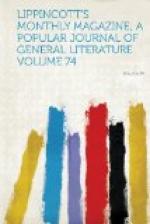the monks in July, 1533, to execute the required works
in the choir for the price of thirty golden crowns
each stall. It will be observed that this price
is about fifty per cent. higher than that for which
Maestro Bino had contracted to do the work, which is
an indication of the then rapidly-falling value of
the precious metals. But this increased price
was still insufficient, for on the 17th of July, 1534,
the monks enter into an amended contract with Maestro
Stefano, in which the terms of the original contract
are rehearsed, and it is then declared that Maestro
Stefano having shown and proved to the abbot’s
satisfaction that those terms could not stand, and
that he should be greatly the loser by the bargain,
and it being by no means the wish of the fathers that
Maestro Stefano should be deprived of a fair reward
for his work, but rather that he should make a suitable
profit by the job, it was now agreed that the maestro
should undertake to labor uninterruptedly and with
all possible diligence, that the convent should find
all materials and tools, and should maintain Maestro
Stefano and his wife and a journeyman, and should
pay sixty golden crowns a year as long as the work
was in progress. Further, the convent undertakes
to pay half a golden crown monthly to the wife of
the said Maestro Stefano, “on the understanding
that the said wife of the maestro shall serve and cook
and wash clothes for all the family engaged on the
work of the choir;” and further, half a golden
crown monthly to the journeyman. Under this arrangement
it was of course the interest of the convent that the
work should be completed as quickly as possible.
And we find, accordingly, the abbot commissioning
Antonio of Florence to carve six of the backs of the
stalls; Battista of Bologna and Ambrose, a Frenchman,
to carve the reading-desk; and Fra Damiano of Bergamo,
who was then at Bologna, to execute the four sculptures
in bas-relief which adorn the door. This Fra
Damiano, who signs himself on his work “Fr. Damianus
de Bergamo, Ordinis Predicatorum,” seems to
have been a brother of the principal artist, Maestro
Stefano. But a curious peep at the manners of
that time is afforded by the fact of a professed monk
working for hire as a wood-carver. The main portion
of the work, however, and the general design, were
due to Maestro Stefano da Zambelli of Bergamo, and
just two years and half from the signing of the contract
the work was completed and signed in intarsia, as
we see it to this day, “Hoc opus fecit M^{r.}
Stephanus di Bergamo.”
For a long time it was supposed that the very beautiful designs for the entirety and for each detail of this noble work was due to Raphael. The guide-books all copied the statement one after the other; and they were indeed excusable in doing so, for the large and magnificent folio which was published at Rome by the abbot and monks in 1845, containing engravings of every detail of the celebrated carvings, declares on the title-page that the work was executed “by




